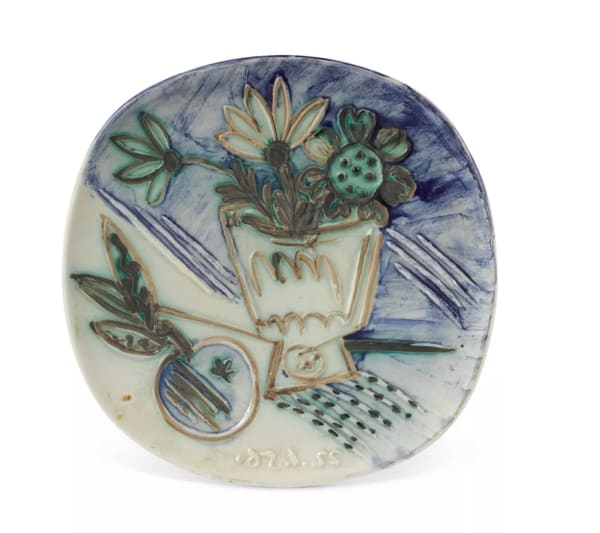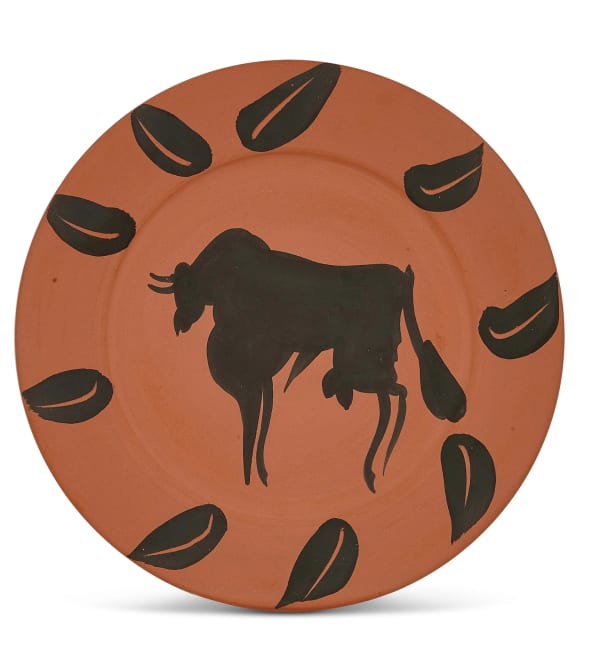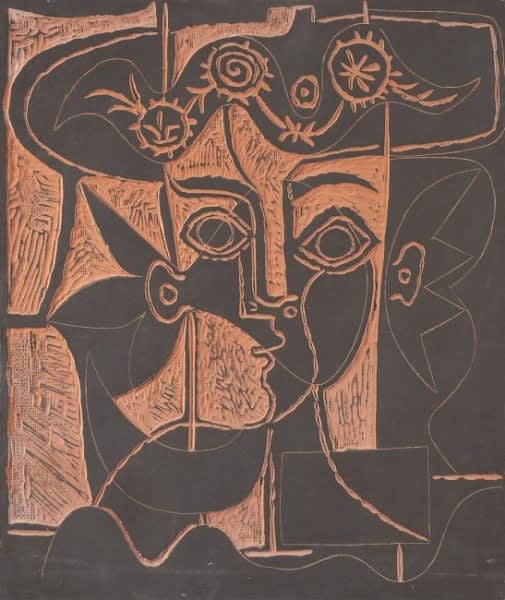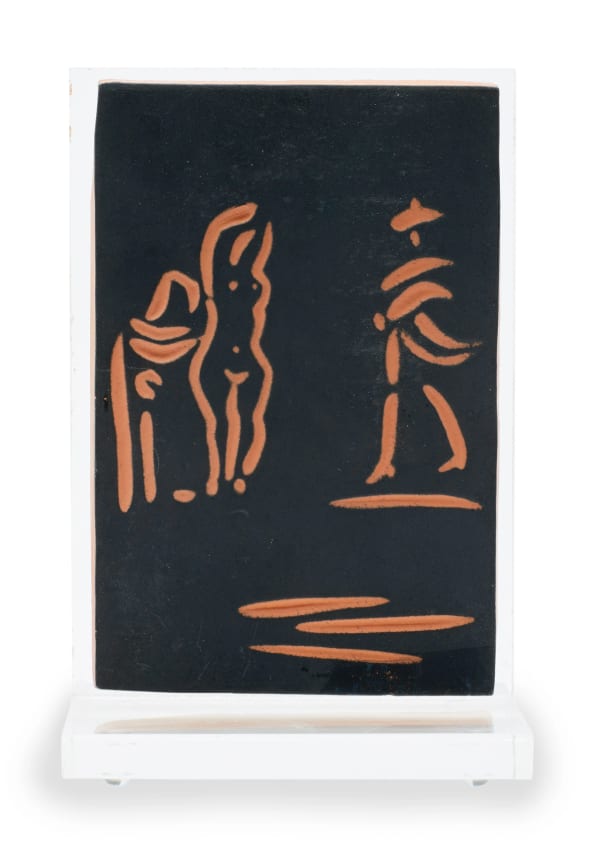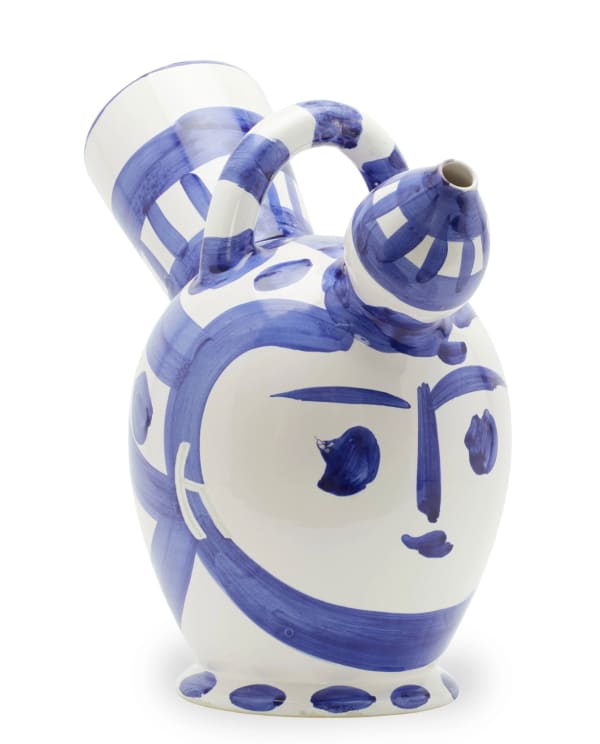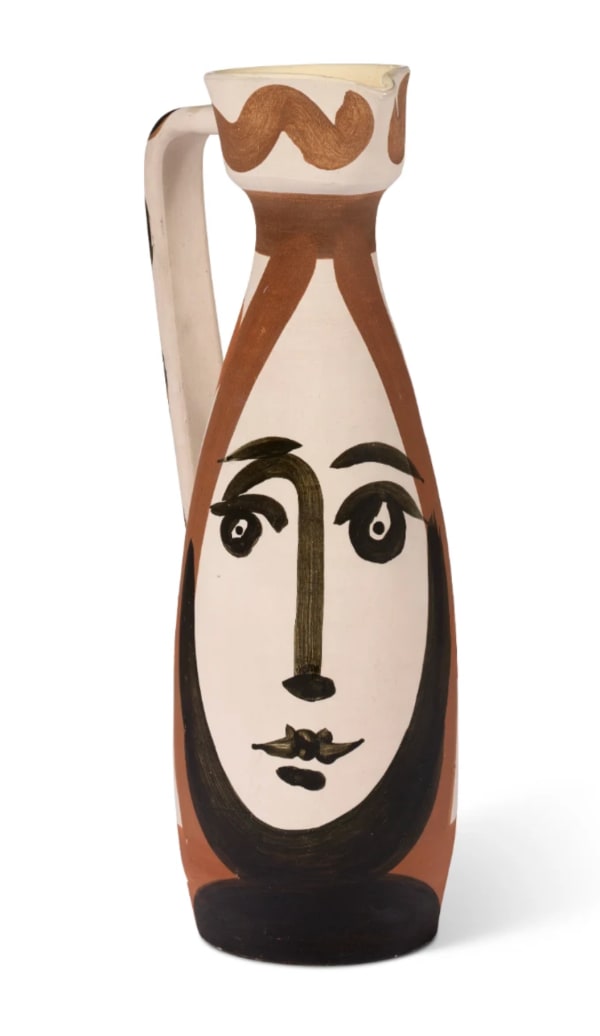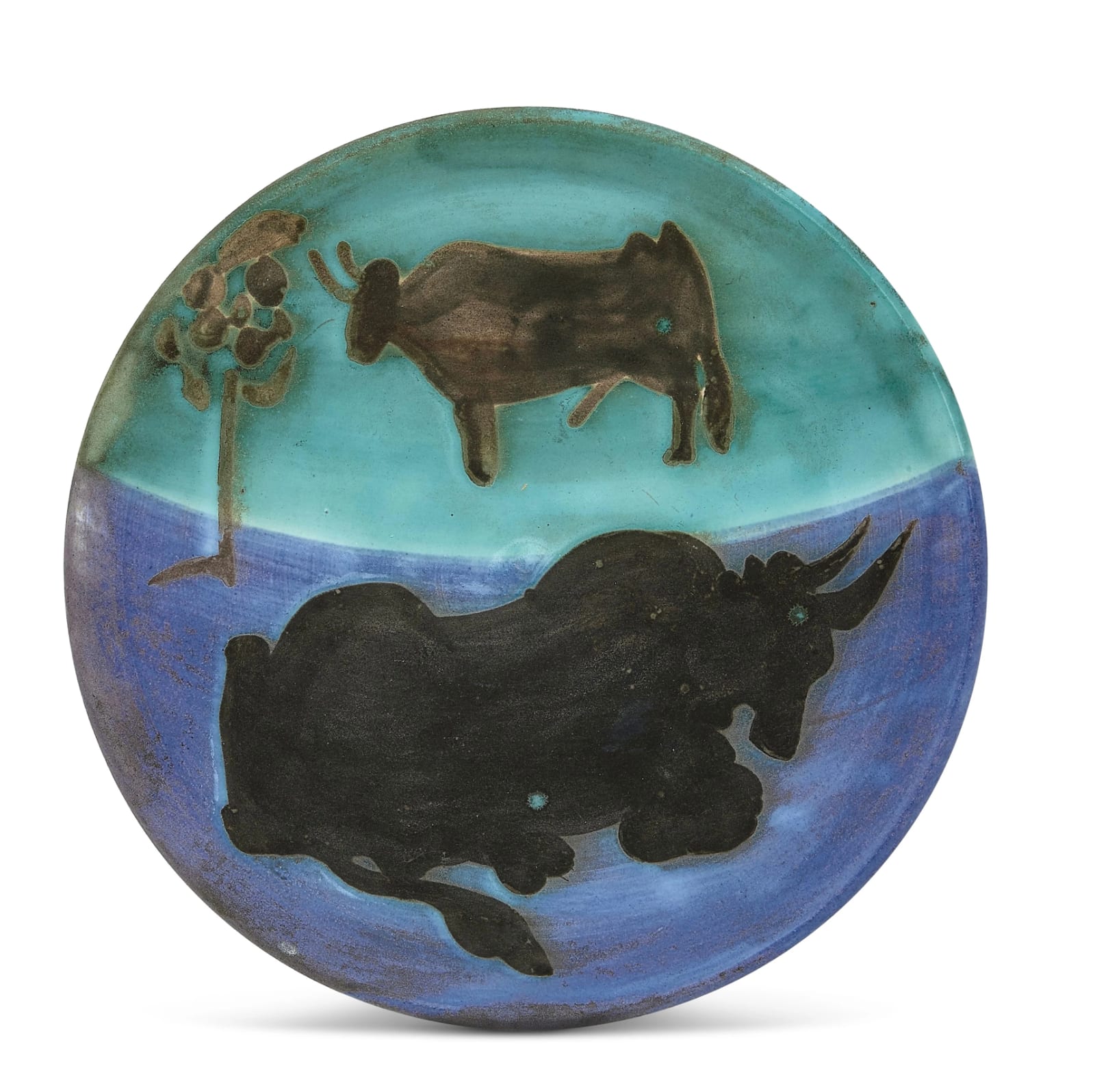
Pablo Picasso
'Edition Picasso' and 'Madoura Plein Feu' stamps on the underside of the plate
Created in 1952 at the Madoura pottery studio in Vallauris, Toros is a striking example of Picasso’s deep-rooted connection to Spanish culture and his ongoing fascination with the bull as an artistic and symbolic subject. Rendered in bold silhouettes upon a vibrant two-tone field of turquoise and indigo, the composition depicts two bulls—one standing beside a tree, the other resting in the foreground. With its rhythmic arrangement and primal simplicity, the plate channels both the timelessness of Mediterranean ceramic traditions and Picasso’s modernist vision.
The bull was not merely an artistic motif for Picasso but a lifelong obsession. From childhood sketches in Málaga, through the Cubist experiments, to his later prints and ceramics, the bull recurs as a central emblem of vitality, struggle, and identity. It is inseparable from Spanish culture: a national symbol bound to ritual, myth, and the drama of the bullfight, an event that Picasso attended with fervor throughout his life. For Picasso, the bull was more than an animal—it was a metaphor for masculine force, creative energy, and the confrontation between life and death.
In Toros, the duality of the bull is emphasized through the juxtaposition of movement and stillness, life and repose. The upright figure suggests defiance and endurance, while the reclining bull exudes weight and permanence, echoing the timeless power of the earth itself. The choice of a ceramic plate as the medium further amplifies this sense of rootedness: unlike a canvas, the earthenware object connects directly to the soil and traditions of Spain and the Mediterranean.
Picasso’s Madoura ceramics of the 1940s and 1950s reflect his delight in experimentation and his ability to imbue functional objects with profound symbolic weight. The glaze’s bold blues evoke both sky and sea, situating the bull within a mythic landscape that transcends specific time or place. As with his Tauromachia etchings or his many drawings of bullfights, Picasso distills the essence of the bull into elemental form, evoking strength and primal vitality with the simplest marks.
Toros thus embodies Picasso’s dual role as innovator and inheritor. While deeply modern in execution, it reaffirms his Spanish roots and the enduring presence of the bull in his imagination. It is both a personal emblem and a universal archetype, an image at once intimate and monumental, linking Picasso’s individual creativity to the broader cultural and mythological heritage of Spain.
For more information or to buy Toros by Pablo Picasso, contact our galleries using the form below.-
 Pablo PicassoVisage, 1963
Pablo PicassoVisage, 1963 -
 Pablo PicassoVisage gravé , 1948
Pablo PicassoVisage gravé , 1948 -
 Pablo PicassoDanseurs, 1956
Pablo PicassoDanseurs, 1956 -
 Pablo PicassoBouquet à la pomme , 1956
Pablo PicassoBouquet à la pomme , 1956 -
 Pablo PicassoVisage no. 197, 1963
Pablo PicassoVisage no. 197, 1963 -
 Pablo PicassoVisage géométrique, 1956
Pablo PicassoVisage géométrique, 1956 -
 Pablo PicassoVisage, 1965
Pablo PicassoVisage, 1965 -
 Pablo PicassoService visage noir, 1948
Pablo PicassoService visage noir, 1948 -
 Pablo PicassoProfil de Jacqueline, 1956
Pablo PicassoProfil de Jacqueline, 1956 -
 Pablo PicassoTaureau, marli aux feuilles, 1957
Pablo PicassoTaureau, marli aux feuilles, 1957 -
 Pablo PicassoTaureau sous l'arbre, 1952
Pablo PicassoTaureau sous l'arbre, 1952 -
 Pablo PicassoGrande Tête De Femme Au Chapeau Orné, 1964
Pablo PicassoGrande Tête De Femme Au Chapeau Orné, 1964 -
 Pablo PicassoGrand Tête de Femme au Chapeau Orné (Ramié 518), 1964
Pablo PicassoGrand Tête de Femme au Chapeau Orné (Ramié 518), 1964 -
 Pablo PicassoCentaure, 1956
Pablo PicassoCentaure, 1956 -
 Pablo PicassoGothic Pitcher with Leaves | Pichet gothique aux feuilles, 1952
Pablo PicassoGothic Pitcher with Leaves | Pichet gothique aux feuilles, 1952 -
 Pablo PicassoFemme échevelée, 1963
Pablo PicassoFemme échevelée, 1963 -
 Pablo PicassoDeux Oiseaux, 1963
Pablo PicassoDeux Oiseaux, 1963 -
 Pablo PicassoPicador, 1952
Pablo PicassoPicador, 1952 -
 Pablo PicassoPaysage, 1953
Pablo PicassoPaysage, 1953 -
 Pablo PicassoProfil de Jacqueline, 1956
Pablo PicassoProfil de Jacqueline, 1956 -
 Pablo PicassoPlongeurs, 1956
Pablo PicassoPlongeurs, 1956 -
 Pablo PicassoCorrida sur fond noir, 1953
Pablo PicassoCorrida sur fond noir, 1953 -
 Pablo PicassoFemmes et toréador, 1968
Pablo PicassoFemmes et toréador, 1968 -
 Pablo PicassoFigure de proue, 1952
Pablo PicassoFigure de proue, 1952 -
 Pablo PicassoPichet à glace, 1952
Pablo PicassoPichet à glace, 1952 -
 Pablo PicassoVisage au nez pincé, 1959
Pablo PicassoVisage au nez pincé, 1959 -
 Pablo PicassoVisage, 1955
Pablo PicassoVisage, 1955
Join our mailing list
* denotes required fields
We will process the personal data you have supplied in accordance with our privacy policy (available on request). You can unsubscribe or change your preferences at any time by clicking the link in our emails.
This website uses cookies
This site uses cookies to help make it more useful to you. Find out more about cookies.



